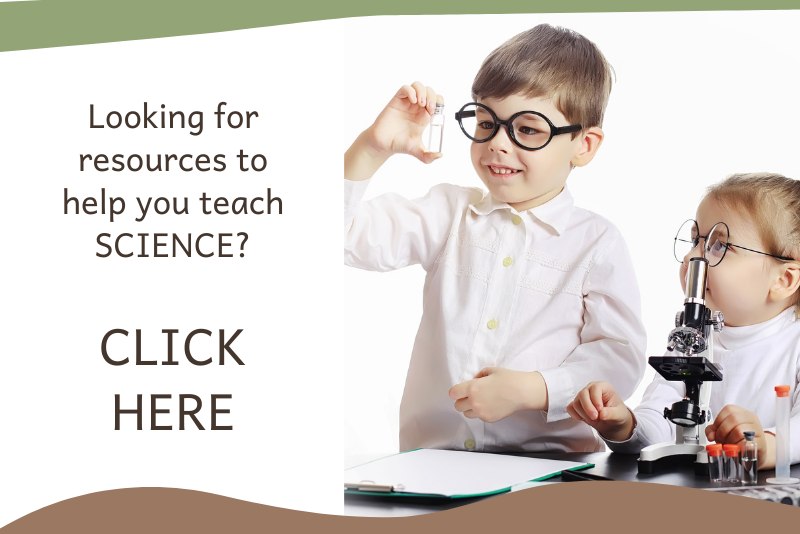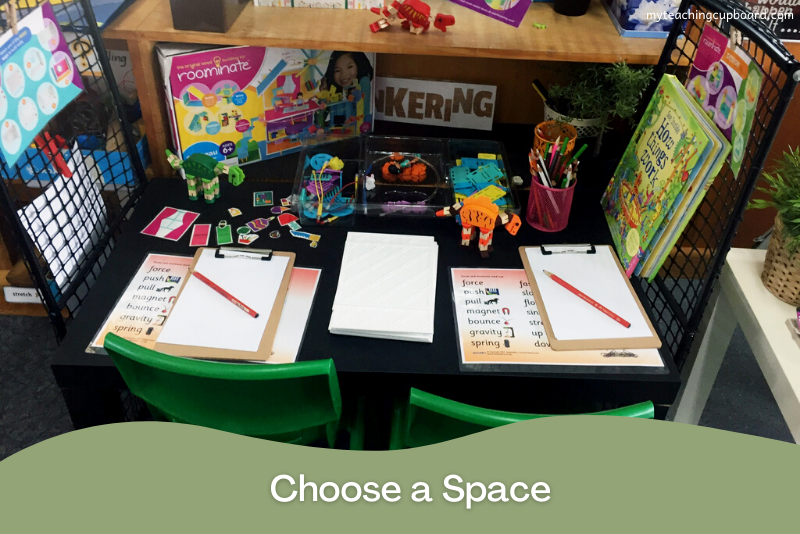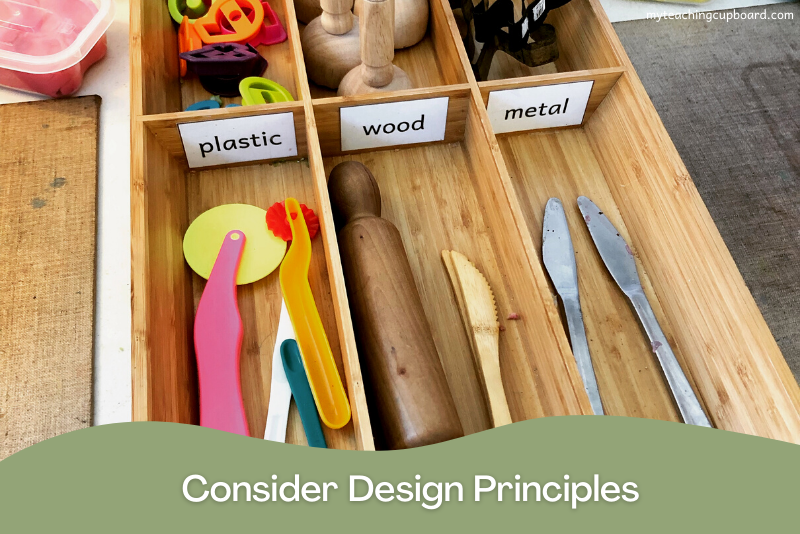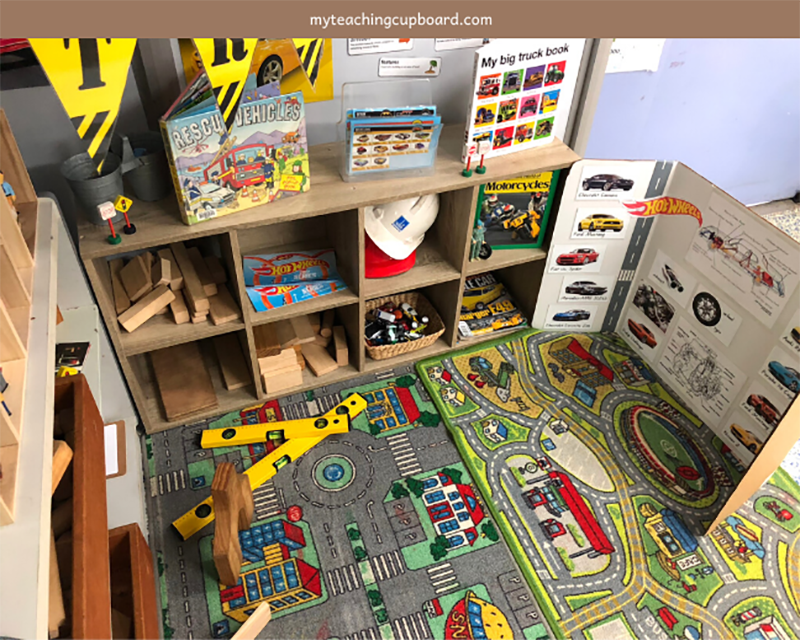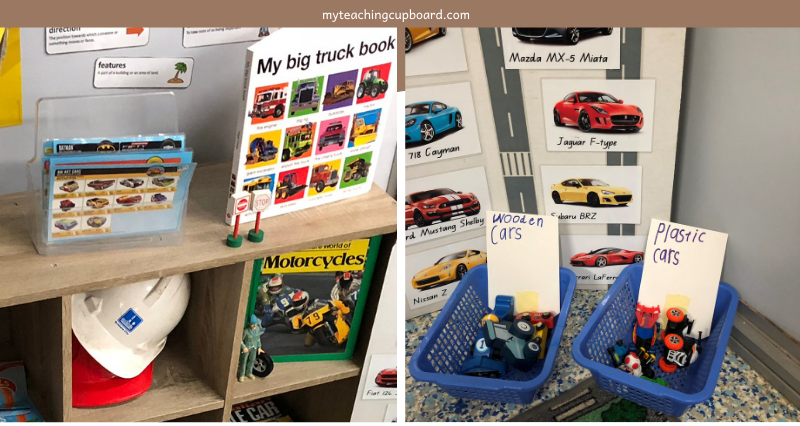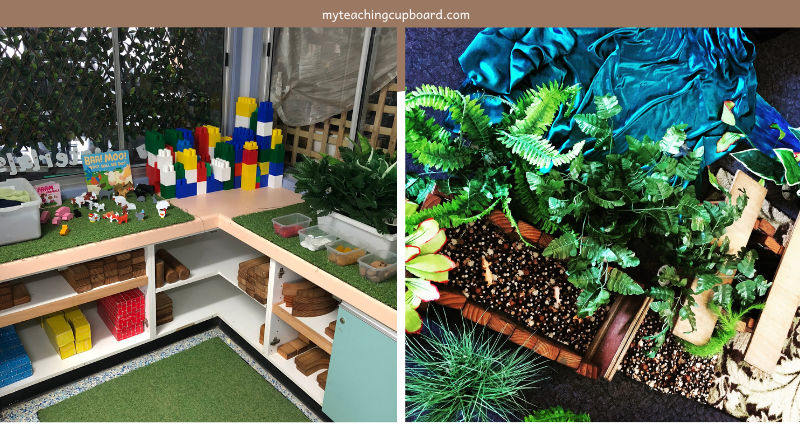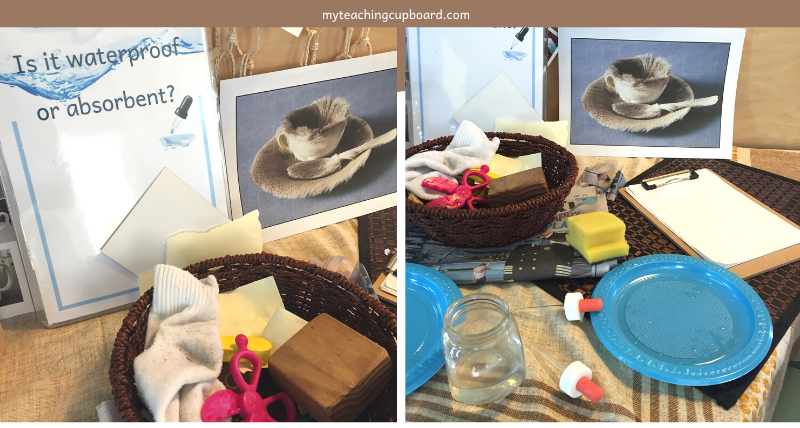Science Provocations – Properties of Materials
If you are teaching the early years chemistry strand and looking for some engaging and educational science provocations to help you teach about Materials and their Properties, this blog post has 5 material world provocations to inspire you.
There are also tips and ideas to help you set up your very own purposeful early childhood science learning provocations.
What is a Science Learning Provocation?
A science learning provocation is a hands-on learning invitation. It is set up in your classroom to "provoke" scientific thinking and learning.
They should be intentionally and purposefully designed by the teacher and invite children to explore and investigate concepts and ideas related to the science curriculum learning intentions.
Whenever I introduce a new science learning provocation to the children, I always refer to the specific learning intention it has been designed to teach. The learning intentions and the related learning provocations are often revised and discussed during the Tuning-in session at the start of each day. We might refer to them again during reflection time and then again later in the day if we have a science lesson.
I have designed some illustrated learning intentions for the foundation stage Material World unit and you can grab them for FREE HERE. They would be great to display at your learning provocations too. Displaying the learning intention is a nice reminder and can help focus the learning.
Although you need to design your science provocations with the curriculum learning intentions in mind, the science curriculum is not the only thing you need to consider. To ensure you are offering a purposeful learning invitation, your children’s interests and developmental needs should also be considered.
To set up an intentional investigation area where your children can explore materials and their properties, you will need to have a comprehensive understanding of two things.
1. the curriculum
2. your children
If you would like some clarification on the ACARA science curriculum and how to teach it effectively though play based and inquiry learning, you might like to check out this blog post: Teaching Science in Early Childhood
In this blog post you will discover how to effectively teach the Science curriculum and all the science learning intentions through hands-on science learning provocations.
How To Set Up Science Learning Provocations
Setting up your science provocations can be as simple or as elaborate as you like. Follow these 3 easy steps to set up purposeful science learning provocations in your classroom.
1. Choose a space
A provocation for learning about the properties of materials should be set up in a clearly defined space. Most teachers choose a designated science table or bench. You can also set up engaging and effective learning provocations in a portable tray, on a shelf or on the floor. The size of the area is dependent on the learning intent and resources you will be using.
2. Consider design principles
If you consider basic design principles when you set up your science learning provocations, your investigation area will be inviting and engaging. A well-designed science learning space does require a bit of thoughtful planning.
Design the area so it will be easy for your children to keep tidy. Well organised and labelled resources in baskets and containers are easily tidied up by the children. An organised science area sends the message to your children that the resources should be respected and cared for.
A cluttered investigation area can be distracting and may even negatively impact on focused learning too.
The design principals of colour, texture and lighting will directly influence the aesthetics of your science investigation areas. Consider using natural materials, soft lighting, and neutral tones to create a peaceful focused space.
3. Reinforce learning intentions
Focus on your science curriculum learning intentions by adding relevant resources and tools to your learning invitations. Think about texts, posters, illustrated learning intentions and vocabulary cards related to the material world.
If you would like some illustrated learning intentions for The Materials unit, there is a free set for you HERE in the Free Resource Library.
Also add clipboards, blackboards, whiteboards, cameras, or blank notebooks for your children to record their learning. Their documentation can be discussed during the reflection time with the whole class or during your explicit science teaching lessons.
You might also like to add direct challenges or prompts related to materials and their properties. The learning prompts can be linked to your science curriculum learning intentions but may also come directly from the children’s interests and developmental needs.
Now you know what a science learning provocation is and how to set up your own purposeful and engaging science investigation area, check out the following learning provocation ideas for teaching about materials and their properties.
5 Ideas for Science Investigation Areas to Teach About The Properties of Materials
Play Dough Table
Science Learning Intentions:
Objects are made of materials that have observable properties (ACSSU003)
Everyday materials can be physically changed in a variety of ways (ACSSU018)
A push or a pull affects how an object moves or changes shape (ACSSU033)
Science involves observing, asking questions about, and describing changes in, objects and events (ACSHE013)(ACSHE034)
Participate in guided investigations and make observations using the senses (ACSIS011)
Pose and respond to questions about familiar objects and events (ACSIS014)
Engage in discussions about observations and represent ideas (ACSIS233)
Share observations and ideas (ACSIS012)
Use informal measurements to collect and record observations, using digital technologies as appropriate (ACSIS026) (ACSIS039)
Use a range of methods to sort information, including drawings and provided tables and through discussion, compare observations with predictions (ACSIS027)
Represent and communicate observations and ideas in a variety of ways (ACSIS029) (ACSIS042)
Pose and respond to questions, and make predictions about familiar objects and events (ACSIS024) (ACSIS037)
Compare observations with those of others (ACSIS213) (ACSIS041)
Participate in guided investigations to explore and answer questions (ACSIS038)
What you will need:
play dough
play dough technique cards - you can download my set HERE
play dough tools (cutters, knives, scissors, stampers and rolling pins) made of various materials like wood, plastic and metal
texts, posters, prompts & vocab cards about materials and their properties
clipboards, paper & pencils
Hot Wheels Investigation Area
Science Learning Intentions:
Objects are made of materials that have observable properties (ACSSU003)
A push or a pull affects how an object moves or changes shape (ACSSU033)
Science involves observing, asking questions about, and describing changes in, objects and events (ACSHE013)(ACSHE034)
Participate in guided investigations and make observations using the senses (ACSIS011)
Pose and respond to questions about familiar objects and events (ACSIS014)
Engage in discussions about observations and represent ideas (ACSIS233)
Share observations and ideas (ACSIS012)
Use informal measurements to collect and record observations, using digital technologies as appropriate (ACSIS026) (ACSIS039)
Use a range of methods to sort information, including drawings and provided tables and through discussion, compare observations with predictions (ACSIS027)
Represent and communicate observations and ideas in a variety of ways (ACSIS029) (ACSIS042)
Pose and respond to questions, and make predictions about familiar objects and events (ACSIS024) (ACSIS037)
Compare observations with those of others (ACSIS213) (ACSIS041)
Participate in guided investigations to explore and answer questions (ACSIS038)
What you will need:
a selection of toy cars made from different materials like wood, plastic and metal
labelled baskets for sorting the cars
optional road play mat
optional toy road signs
variety of ramps or blocks to make ramps
spirit levels
measuring tapes and rulers
stopwatches and timers
texts, posters, prompts & vocab cards about cars and the properties of materials
clipboards, paper & pencils
Material World Block Play
Science Learning Intentions:
Objects are made of materials that have observable properties (ACSSU003)
Everyday materials can be physically changed in a variety of ways (ACSSU018)
A push or a pull affects how an object moves or changes shape (ACSSU033)
Science involves observing, asking questions about, and describing changes in, objects and events (ACSHE013) (ACSHE034)
Participate in guided investigations and make observations using the senses (ACSIS011)
Pose and respond to questions about familiar objects and events (ACSIS014)
Engage in discussions about observations and represent ideas (ACSIS233)
Share observations and ideas (ACSIS012)
Science involves observing, asking questions about, and describing changes in, objects and events
Use informal measurements to collect and record observations, using digital technologies as appropriate (ACSIS026) (ACSIS039)
Use a range of methods to sort information, including drawings and provided tables and through discussion, compare observations with predictions (ACSIS027)
Represent and communicate observations and ideas in a variety of ways (ACSIS029) (ACSIS042)
Pose and respond to questions, and make predictions about familiar objects and events (ACSIS024) (ACSIS037)
Compare observations with those of others (ACSIS213) (ACSIS041)
Participate in guided investigations to explore and answer questions (ACSIS038)
What you will need:
a selection of building blocks made from different materials like plastic mega blocks, cardboard boxes and tubes, plastic gutters and pipes, metal trays hardware and blocks, wooden blocks
loose parts made from different materials like wood cookies and sticks, stones, artificial plants, pieces of different textured fabric, glass gems, plastic turf in different sizes, plastic and wooden animals and figures
tape measures, rulers and timers
optional sensory bases like bark, sand or straw
texts, posters, prompts & vocab cards about materials and the properties of different materials
clipboards, paper & pencils
Kitchen Science Lab
Science Learning Intentions:
Objects are made of materials that have observable properties (ACSSU003)
Everyday materials can be physically changed in a variety of ways (ACSSU018)
Science involves observing, asking questions about, and describing changes in, objects and events (ACSHE013) (ACSHE034)
Participate in guided investigations and make observations using the senses (ACSIS011)
Pose and respond to questions about familiar objects and events (ACSIS014)
Engage in discussions about observations and represent ideas (ACSIS233)
Share observations and ideas (ACSIS012)
People use science in their daily lives, (ACSHE022) (ACSHE035)
Use informal measurements to collect and record observations, using digital technologies as appropriate (ACSIS026) (ACSIS039)
Use a range of methods to sort information, including drawings and provided tables and through discussion, compare observations with predictions (ACSIS027)
Represent and communicate observations and ideas in a variety of ways (ACSIS029) (ACSIS042)
Pose and respond to questions, and make predictions about familiar objects and events (ACSIS024) (ACSIS037)
Compare observations with those of others (ACSIS213) (ACSIS041)
Participate in guided investigations to explore and answer questions (ACSIS038)
What you will need:
a selection of kitchen ingredients in labelled containers (salt, flour, coloured water, bi-carb, vinegar, cooking oil, sprinkles, cocoa, citric acid, ground herbs and spices, rice, cornflour, etc)
measuring spoons and cupc
small mixing bowls
pippettes, funnels, and very small jugs and mixing bowls or culture trays
disposal rubbish bucket, tea towels and a basin of warm soapy water for washing utensils
pop sticks for mixing
optional placemats
optional science lab coats and safety glasses
optional microscope and specimen slides
texts, posters, prompts & vocab cards about cooking, experiments materials and the properties of different materials
clipboards, paper & pencils
You can check out more pics and information HERE on this old blog post - Kitchen Science Chemistry Lab
Waterproof Testing Science Table
Science Learning Intentions:
Objects are made of materials that have observable properties (ACSSU003)
Everyday materials can be physically changed in a variety of ways (ACSSU018)
Science involves observing, asking questions about, and describing changes in, objects and events (ACSHE013)(ACSHE034)
Participate in guided investigations and make observations using the senses (ACSIS011)
Pose and respond to questions about familiar objects and events (ACSIS014)
Engage in discussions about observations and represent ideas (ACSIS233)
Share observations and ideas (ACSIS012)
People use science in their daily lives, (ACSHE022) (ACSHE035)
Use informal measurements to collect and record observations, using digital technologies as appropriate (ACSIS026) (ACSIS039)
Use a range of methods to sort information, including drawings and provided tables and through discussion, compare observations with predictions (ACSIS027)
Represent and communicate observations and ideas in a variety of ways (ACSIS029) (ACSIS042)
Pose and respond to questions, and make predictions about familiar objects and events (ACSIS024) (ACSIS037)
Compare observations with those of others (ACSIS213) (ACSIS041)
Participate in guided investigations to explore and answer questions (ACSIS038)
What you will need:
a selection of absorbent and waterproof materials like different papers and card, soft and hard plastics, metal sheets, alfoil, clingwrap, different fabrics, sponges and thin pieces of wood
small jars or jugs of water
pippettes or dropppers
shallow trays to work in
spray bottles of water
towels for cleaning up
texts, posters, prompts & vocab cards about materials and their waterproof properties
clipboards, paper & pencils
Now all you need to do is grab some resources and get started. I would love to see any of the provocations about materials and their properties that you set up in your room. If you post any pics on Instagram – please tag me @myteachingcupboard so I can check them out!
If you liked this post on my science provocations about the properties of materials, please consider sharing it...
Just CLICK the sharing box below.👇



